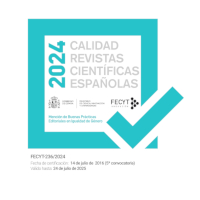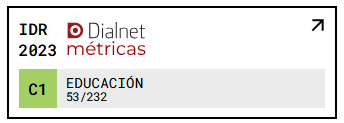Revisión de las tendencias en la evaluación psicopedagógica
DOI:
https://doi.org/10.18172/con.405Abstract
It is created the classic aproach about learning disabilities analysis by instruments taking results and doing classications. It is commented the incidences, in the curricular field, of advancements in the cognitive psychology and elaboration of new evaluation procedures and measurement in the school context, realizing a psychoneurology focusing review, abilities analysis and possibilities of the new evaluation tendences of execution procesessess (Assessmente authentic, portfolios....). It is urged to specifications of research ways that will determinate another evaluation procedures in the psychoeducatives processes.Downloads
References
ARTER, J. A. y JENKINS, J. R. (1979): “Differential diagnosis - prescriptive teaching: a critical appraisal” Review of Educational Research, 49(4), 517-555.
BRAVO, C. (1983): Caracterización del receptor colinérgico de la placa motora. Madrid. UCM.
BUNGE, M. (1980): El problema mente-cerebro. Un enfoque psicobiológico. Madrid. Tecnos.
BUNGE, N. (1989): Mente y sociedad. Alianza Editorial. Madrid.
BUNGE, M. (1993); Epistemología de las Ciencias Sociales. Santander. UIMP.
CLAPARÉDE, E. (1918): L’ecole sur mesure. París. Payot.
FREDERIKSEN, N., MISLEVY, R. J. y BEJAR, I. I. (1993): Test theory for a new generation of tests. Hillsdale. Earbaum.
GALI, A. (1928): Lamesura objectiva del treball escolar. Biblioteca Pedagógica. Barcelona.
GARCIA YAGÜE, J. y otros (1987): Diagnóstico pedagógico y técnicas de orientación. Madrid. UNED.
GITOMER, D. H. y YAMAMOTO, K. (1991): Permance modeling that integrates latent trit and class theory. Princeton. Educational Testing Service.
GLASER, R., LESGOLD, A. y LAJOIE, S. (1987): “Toward a cognitive theory for the measurementof achievement” en Ronnig, R., Glover, J., Conoley, J. C. y Witt, J. (Eds): The influence of cognitive psychology on testing and measurement: The Buros-Nebraska Symposium.on measurements and testing. Vol 3. Hilldale. Earlbaum.
HEBB, D. (1968); Psicolog’a. Madrid. Interamericana.
LANE, S. (1993): “The conceptual framework for the development mathematics performance assessment instrument” Educational measurement, 12(2), 16-23.
LÁZARO, A. (1989): “Orientación de las dificultades de aprendizaje” en Arana, J. (Ed): Disfunciones cerebrales del aprendizaje. Instituto de Ciencias del Hombre. Madrid.
LOPEZ del CASTILLO, M. T. (1964): Método Decroly” en García Hoz, V. (Ed.): Diccionario de Pedagogía. Barcelona. Labor.
MASTERS, G. M. y MISLEVY, R. (1991): New views of students learning: implications for educational measurement. Princeton. Educational Testing Service.
MISCHEL, W. (1980): Personalidad y Evaluación. México. Trillas.
ORDEN, A., GAVIRIA, J. L., FUENTES, A. y LÁZARO, A. (1994): “Modelos de cosntrucción y validación de instrumentos psicopedagógicos”. Revista de Investigación Educativa, 23, 129-178.
PAWSON, R. y TILLEY, N. (1997): Realistic evaluation. Londres. Sage.
REMY, E. (1921): Un essai d’enseignement sur mesure. Paris. Collin.
STTINGINS, R. J. (1991): “Facing the challenges of a new era of educational assessment”. Applied measurement in education, 4,4, 263-273.
THORNDIKE, E. L. (1913): “Educational measurement” Journal Educational measuremente, IV, 551-12. En García Yagüe, J.: Diagnóstico pedagógico y técnicas de orientación. Madrid. UNED.
TORNDIKE, E. L. (1918): “The nature, porpuse and general methods of measurement of educational productts”. XVI yearbook of the national society for study of education. 16-22.
VANEY, L. (1904): “Nouveles methodes de mesure applicables au degre d’instruction des eleves” L’année psychologie. 146-162. Cit García Yagüe, J: Diagnóstico pedagógico y técnicas de orientación. UNED. Madrid.
VIVES, J. L. (1947): “Enseñanza de las disciplinas” en Galino, A. (Ed.): Textos pedagógicos hispanoamericanos. Madrid. Narcea. 265-266.
Downloads
Published
How to Cite
Issue
Section
License
The authors retain copyright of articles and authorize Contextos Educativos. Revista de Educación the first publication. They are free to share and redistribute the article without obtaining permission from the publisher as long as they give appropriate credit to the editor and the journal.
Self-archiving is allowed too. In fact, it is recommendable to deposit a PDF version of the paper in academic and/or institutional repositories.












